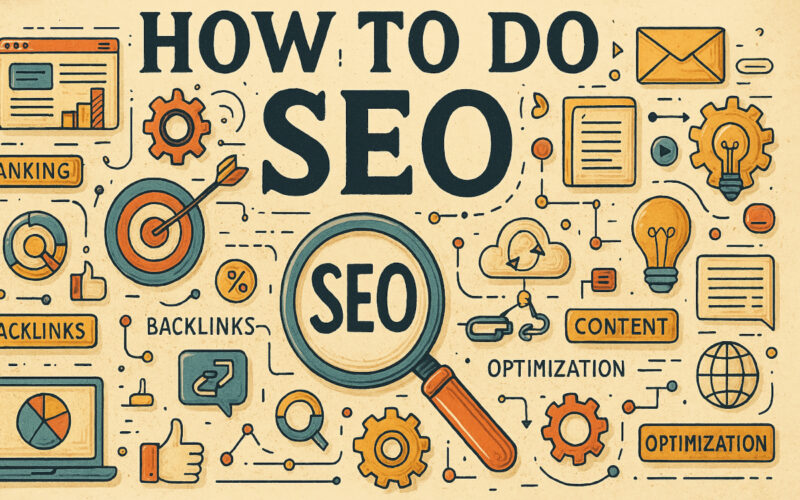Imagine you have a website with excellent products or highly useful articles, but no visitors. It’s as if it were hidden, with no one knowing it exists. At this point, SEO becomes essential to make it visible. SEO (Search Engine Optimization) is a fundamental strategy to improve a website’s visibility in search engines like Google. In an increasingly competitive digital environment, knowing how to apply SEO is key to standing out among millions of results.
Without a doubt, SEO is an essential tool for increasing your site’s presence in search results. Whether you’re launching your first website or looking to optimize an existing one, understanding how SEO works can make the difference between going unnoticed and appearing on Google’s first page. In this article, I’ll show you how to do SEO step by step, from the basics to more advanced strategies, with a practical and easy-to-implement approach.
What is SEO and why is it important to do it?
This isn’t the first time we’ve answered the question what is SEO and what is it for. As we’ve mentioned before, SEO, or Search Engine Optimization, is the set of techniques and strategies applied to a website to improve its position in the organic (unpaid) results of search engines like Google, Bing, etc.
Think of it as preparing your physical store to be attractive, easy to find, and located on the main street of the digital city. When someone searches for something related to what you offer, you want to be one of the first options they see.
The key question is why do SEO. The answer is simple: visibility. In a saturated digital world, if you don’t appear on the first pages of results, it’s as if you don’t exist for a large part of your potential audience.
93% of online experiences begin with a search engine, and 75% of users never go past the first page of results. Therefore, a well-implemented SEO strategy not only brings more qualified traffic to your site (people who are genuinely interested in what you offer), but also builds your brand’s authority and credibility, improving your long-term ranking. For anyone wondering how to get started with SEO, understanding this importance is the first and most crucial step.
First steps to do SEO on your website
If you’re just starting out and wondering “how to do SEO from scratch”, the first step is to make sure your site is well structured and connected with key tools like Google Search Console and Google Analytics. Setting up these platforms is essential; they are like the control panel and eyes of your strategy, allowing you to monitor your website’s performance, index content, and understand how users interact with it.
You’ll also need keyword research tools like Google Keyword Planner, Ahrefs, or Semrush, which will help you identify the terms your target audience is searching for.
The next step is to evaluate your website’s current structure. Is it easy to navigate? Is the content logically organized? Do the pages load quickly? These aspects directly influence the user experience, a factor that Google increasingly values when determining rankings.
When starting an SEO strategy from scratch, think in terms of solving real problems for your potential users, not just manipulating algorithms. This user-centered approach will help you build a strong foundation for your optimization efforts. Remember, you’re building the foundation; detailed optimization will come later, but without a good base, future efforts will have less impact.
Conducting an initial SEO audit
Before you start optimizing, you need to know where you stand. Conducting an initial SEO audit is like giving your website a medical check-up. It involves reviewing technical and content aspects to identify problems and improvement opportunities.
Key elements to check include loading speed and Core Web Vitals (does the content take too long to appear?), mobile responsiveness (does it look good on smartphones and tablets?), the presence of 404 errors (page not found), and the overall site structure (is it logical and easy to navigate?).
There are very useful tools to perform this diagnosis. Tools like Google’s PageSpeed Insights will tell you how fast your site loads and offer suggestions for improvement. More advanced tools like Screaming Frog or the Site Audit feature in Ahrefs can crawl your entire site, simulating what Google would do, to detect deeper technical issues. Understanding how to perform a basic SEO analysis will give you a clear roadmap of which aspects to prioritize in your initial strategy.
Keyword analysis
Keyword analysis is the heart of any SEO strategy. It involves researching and understanding what terms people use to search for information, products, or services like yours on search engines. It’s like learning the language of your target audience.
Tools like Google Keyword Planner (free with a Google Ads account), SE Ranking, or the keyword research features of Semrush and Ahrefs are essential in this process. These platforms show you the search volume, ranking difficulty, and suggestions for related keywords.
At this point, it’s important to clarify that not all keywords are the same. It’s crucial to differentiate between informational keywords (e.g., “what is medical SEO“, “what is an account manager“) and transactional keywords (e.g., “digital marketing agency” or “SEO agency in Argentina“). Choosing the right keywords—those that are relevant to your business and have a reasonable search volume and manageable competition—will allow you to attract the right audience at the right moment in their decision-making process. This step defines where you will focus your content creation and optimization efforts.
If you want to learn more about what keywords are, we have a full article dedicated to the topic. We recommend giving it a read to dive deeper.
Site structure: URLs, H1, H2, and navigation
Imagine walking into a library where the books aren’t organized by sections and don’t have clear titles. It would be a nightmare to find anything, right? The same goes for your website. A well-organized structure is essential both for the user experience and for SEO. This means having intuitive navigation, descriptive URLs, and a logical heading hierarchy (H1, H2, H3…) within each page.
A good website structure is fundamental for both users and search engines. Below are the main aspects you should consider:
- Optimized URLs:
- They should be short, clear, and descriptive.
- It’s important to include the page’s main keyword.
- Avoid unnecessary parameters or strings of numbers that add no meaning (for example, tusite.com/services/seo-consulting is better than tusite.com/page_id=123).
- Use hyphens (-) to separate words, as they are better interpreted by search engines.
- H1 Header (main title):
- It should be unique on each page.
- It must clearly describe what the content is about.
- Including the main keyword naturally is recommended.
- It represents the highest content hierarchy, so it shouldn’t be repeated elsewhere on the page.
- H2, H3, and subsequent headers:
- They help organize the content into sections and subsections.
- They improve readability, making it easier to navigate for both users and search engines.
- They also help highlight secondary or related topics, and can include variations or synonyms of the main keyword.
- Structural coherence:
- Maintaining a logical hierarchy (H1 > H2 > H3) helps the content appear “well organized.”
- This structure acts as a clear map that guides both visitors and Google through the content efficiently.
- Additionally, it can increase the chances of your content appearing in featured snippets if it’s well structured.
How to optimize content for SEO
Creating content is only half the battle; optimizing it for search engines is the other crucial half. The goal is to create useful content that not only answers the user’s search intent (what do they really want to achieve or know?) but is also valuable, readable, and structured in a way that Google can easily understand. This means using the researched keywords naturally (avoid keyword stuffing at all costs!), writing short paragraphs, using subheadings (H2, H3), lists, and visual elements to improve readability.
Knowing how to create effective SEO content also means thinking long term. Evergreen content (the kind that remains relevant over time, such as fundamental guides or tutorials) can attract consistent traffic for months or even years.
For example, an article about “what is digital marketing” will remain relevant for a long time, while one about “Digital Marketing Trends 2023” will have a shorter lifespan. Providing real value and keeping your content updated are key to gaining and maintaining rankings in search results, following SEO best practices and Google’s Helpful Content guidelines.
On-page optimization: title, meta description, and tags
On-page elements like the SEO title (the <title> tag) and meta description are your calling card in search results. They’re the first thing a user sees, and although the meta description isn’t a direct ranking factor, it heavily influences the click-through rate (CTR).
A good SEO title should be concise (around 60 characters), include the main keyword, and be compelling. Think of it as a news headline: it should grab attention and summarize the content.
The meta description (about 155–160 characters) is your chance to “sell” the click. It should complement the title, briefly describe what the page is about, and, if possible, include a subtle call to action.
For example, for a page about vegan recipes, a good meta description might be:
“Discover delicious vegan recipes that are quick and easy. Healthy dishes to surprise your family. Find your favorite one here!”
Optimizing these tags is a small step but has a big impact on your visibility and traffic.
Link building and internal linking
Links are like streets that connect different places in the digital city. There are two main types: internal links and external links (backlinks).
Internal links are those that go from one page on your website to another. They are crucial for user navigation, for distributing “authority” (link juice) within your own site, and for helping Google discover and understand the relationship between your content. A good interlinking strategy involves linking relevant pages to each other naturally, using descriptive anchor text.
External links, or backlinks, are links from other websites to yours. Google sees them as “votes of confidence” or recommendations. The more high-quality links (from relevant and authoritative sites) point to your website, the better your reputation in Google’s eyes. Getting these links (a process known as link building) is an art and takes effort: creating exceptional content that others want to link to, reaching out to other sites, etc. It’s one of the most challenging but also most rewarding parts of SEO.
Social signals and shareable content
Although social signals (shares, likes, comments on social media) are not a confirmed direct ranking factor by Google, they do have a significant indirect impact on SEO. A piece of viral marketing content that gets widely shared on social media gains visibility, which can lead to more traffic to your site and potentially encourage others to discover your content and link to it from their own sites (generating natural backlinks).
What kind of content is most shareable? Generally, content that is useful, entertaining, emotionally resonant, or visually appealing. Infographics, comprehensive guides, original studies, videos, and articles with a unique angle tend to perform well. Encouraging people to share your content by adding share buttons and creating content worth spreading can amplify the reach of your SEO efforts and strengthen your brand’s online presence.
Tips and best practices to maintain your SEO
SEO isn’t something you do once and forget. It’s a marathon, not a sprint. To maintain and improve your rankings, you need to keep applying SEO best practices and stay up to date with Google algorithm updates. One of the most important SEO tips is to keep your content fresh and updated. Regularly review your key pages, update outdated information, and look for ways to add more value.
Monitoring your metrics with Google Analytics and Search Console is vital. Pay attention to organic traffic, keyword rankings, click-through rate (CTR), and bounce rate. Tools like Ahrefs or Semrush offer deeper tracking and competitor analysis.
Another fundamental SEO tip is to be patient and consistent. Results are rarely immediate. Avoid common mistakes like duplicate content, keyword stuffing, or bulk buying of low-quality backlinks. Adapting your SEO strategy based on data and trends (Google Trends can help here) is key to long-term success. Don’t forget these SEO tips in your day-to-day efforts.
Do you need help getting started with SEO on your website?
Navigating the path of how to do SEO from scratch may seem complex at first, but as we’ve seen, it’s based on a series of logical steps and consistent actions. From understanding what SEO is and why it’s crucial, through the initial audit, keyword research, technical and content optimization, to link building and ongoing maintenance, each phase is important to build a strong and visible online presence.
Remember that SEO is a long-term investment. Results don’t happen overnight, but consistent effort and the application of good SEO practices will eventually pay off in the form of greater visibility, qualified traffic, and growth for your project or business. The key lies in patience, continuous learning, and adaptability.If you feel you need expert help to implement your SEO strategy or want to take your results to the next level, at MD Marketing Digital we’re here to help. Explore our SEO services or keep learning with more articles from our blog. The journey to the top of Google continues!
- How to do SEO step by step: keys to ranking your site - April 18, 2025
- What is ecommerce and how does it work? - April 11, 2025
- Google My Business: A Complete Guide - March 31, 2025
¿Qué te pareció este artículo?
What do you think about this post?






